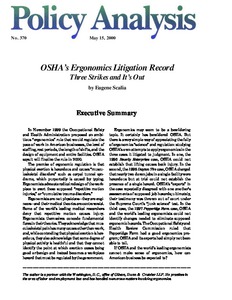OSHA's ergonomics litigation record: three strikes and it's out
"In November 1999 the Occupational Safety and Health Administration proposed an ambitious "ergonomics" rule that would regulate the pace of work in American businesses, the level of staffing, rest periods, the length of shifts, and the design of equipment and entire facilities. OSHA s...
| Main Author: | |
|---|---|
| Institution: | ETUI-European Trade Union Institute |
| Format: | TEXT |
| Language: | English |
| Published: |
Washington, D.C.
2000
Cato Institute |
| Subjects: | |
| Online Access: | https://www.labourline.org/KENTIKA-19294632124910128149-oSHa-s-ergonomics-litigation-r.htm |
| Summary: | "In November 1999 the Occupational Safety and Health Administration proposed an ambitious "ergonomics" rule that would regulate the pace of work in American businesses, the level of staffing, rest periods, the length of shifts, and the design of equipment and entire facilities. OSHA says it will finalize the rule in 2000. The premise of ergonomic regulation is that physical exertion is hazardous and causes "musculoskeletal disorders" such as carpal tunnel syndrome, which purportedly is caused by typing.Ergonomists advocate radical redesign of the workplace to avert these supposed "repetitive motion injuries," or "cumulative trauma disorders."
Ergonomists are not physicians -they are engineers- and their medical theories are controversial. Some of the world's leading medical researchers deny that repetitive motion causes injury. Ergonomists themselves concede fundamental flaws in their theories. They acknowledge that usculoskeletal pain has many causes other than work, and, while contending that physical exertion is hazardous, they also acknowledge that some degree of physical activity is healthful and that they cannot identify the point at which exertion ceases being good or benign and instead becomes a workplace hazard that must be regulated by the government. ..."
(from the author's summary) |
|---|---|
| Physical Description: | 17 p. Digital |

